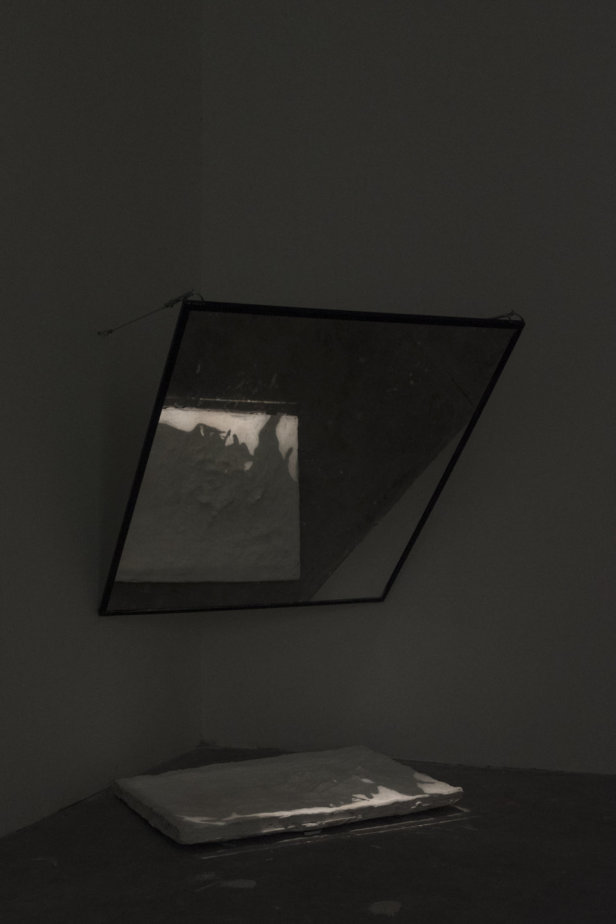Ondřej Vinš’s installation, Pedestrian Thing (2018), can – according to the artist – be understood as a “mechanical-chemical record”. However, in reality, this several-month-long experiment, whose name is borrowed from the eponymous collection of poems by Petr Kabeš, bears in itself the inescapable poetry of absurdity. Its resulting format is, from a creative perspective, both subtle and liberating. He unexpectedly paraphrases the finesse characteristic of photo documentation, without paradoxically, during the process of recording individual phases of movement in the landscape, his camera finding any sort of use. The artist applies the technique of recopying sequential topographical situations from maps onto paper, a record of spatial movement that accentuates the materialness of the analog process. He confronts various models of representation: the precision of cartographic measuring against records of sensor-based and physical movements in the landscape. It is worth pointing out that the mapped terrain used by the artist was the beautiful mountainscapes of the České středohoří (Central Bohemian Highlands) area that is so often visited as part of local landscape traditions. It all makes sense: they stand out not just for the two-dimensional photogenic quality of their silhouettes, but they are also suitable for the “pedestrian thing” and because of their multidimensional presentation thanks to their visibility and sparse vegetation.
Ondřej Vinš often uses analogue cameras and projectors in his work. The romanticizing nostalgia in his art sometimes stands in contrast to his factual post-conceptual speech. Similarly, he surprises with the frugalness with which he sometimes almost overshadows the existential and metaphysical dimension of how he lives out his stays and work done in nature. In one of his older works, the artist notes: “Somewhere far away, far beyond this border, there’s allegedly a land where nighttime never comes, where the sun touches the wrinkled mountains and where you can enter a landscape at the end of the world. All the promises of discovery and encounters with the unknown that move the gentle mechanisms of human desire for questioning and awe of the ability to ask the question… this pushed us along winding paths, forced us to maintain our balance along rugged (fierce) canyons, to negotiate with ferrymen and toll collectors in a dead (arcane) language as old as the landscape itself.”
Maps are a faithful companion of travelers and dreamers. For Ondřej Vinš, his work on Pedestrian Thing represents a fundamental, practical starting point and an object of reflection. Poet Elizabeth Bishop closes her famous poem, The Map (1934), with a reflection on the inspiring and timeless dimensions of cartography (map-making):
Topography displays no favorites; North’s as near as West.
More delicate than the historians’ are the map-makers’ colors. 1
Ondřej Vinš, in his work, also deals with the limits of two-dimensional presentation of the Earth’s surface in maps. In his projects, he researches records on terrain; namely, the roundness and plasticity of the Earth’s surface, inclines shown by topographical contours and his travels take him to the poles. Ancient geographer Eratosthenes of Cyrene, one of the propagators of the Earth being round, attempted using science to dispel myths showing the misguided idea about the Earth’s surface being flat. The misguidedness of these ideas, based to a certain degree on the imperfection of human perception and the physical experience of the landscape, once again comes into play in Ondřej Vinš’s work. The artist uses all his senses to examine the distortion of human perception of physical space and the illusiveness of two-dimensional maps. He also looks for sources in the reflexive figurativeness of others. He follows the creative dialogue of the body and landscape; the scientific quality and poetics.
TALK TO THE MAP, name a small thing: it casts a long shadow? (…)2
Topics related to topography, landscape and spatial mapping recur repeatedly in Ondřej Vinš’s photographs and paintings. Each time though they appear in a different perspective representation or with a different content focus. In the series of paintings, A Study of Shadows in Landscape (2013) he captures, for example, the drastic discontinuity of the post-industrial Most area with ghostly images evoking the well-known metastasis; in his photographs though his approach to people in landscapes is replaced by enlargements from the movie, Big Green Line (2014). The current exhibition, Pedestrian Thing, foreshadows his installation, Transitory Landscape (shown at Perla, 2016) and his “landscape” project, I am not at all below the hills to the West (2017), photographed in Norway and Finland.
Mariana Serranova











